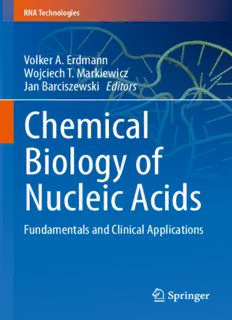
Chemical Biology of Nucleic Acids: Fundamentals and Clinical Applications PDF
Preview Chemical Biology of Nucleic Acids: Fundamentals and Clinical Applications
RNA Technologies Volker A. Erdmann Wojciech T. Markiewicz Jan Barciszewski Editors Chemical Biology of Nucleic Acids Fundamentals and Clinical Applications RNA Technologies For furthervolumes: http://www.springer.com/series/8619 ThiSisaFMBlankPage Volker A. Erdmann (cid:129) Wojciech T. Markiewicz (cid:129) Jan Barciszewski Editors Chemical Biology of Nucleic Acids Fundamentals and Clinical Applications Editors VolkerA.Erdmann WojciechT.Markiewicz InstituteofChemistry/Biochemistry JanBarciszewski FreeUniversityBerlin InstituteofBioorganicChemistry Berlin,Germany PolishAcademyofSciences Poznan,Poland ISBN978-3-642-54451-4 ISBN978-3-642-54452-1(eBook) DOI10.1007/978-3-642-54452-1 SpringerHeidelbergNewYorkDordrechtLondon LibraryofCongressControlNumber:2014937792 ©Springer-VerlagBerlinHeidelberg2014 Thisworkissubjecttocopyright.AllrightsarereservedbythePublisher,whetherthewholeorpart of the material is concerned, specifically the rights of translation, reprinting, reuse of illustrations, recitation,broadcasting,reproductiononmicrofilmsorinanyotherphysicalway,andtransmissionor informationstorageandretrieval,electronicadaptation,computersoftware,orbysimilarordissimilar methodologynowknownorhereafterdeveloped.Exemptedfromthislegalreservationarebriefexcerpts inconnectionwithreviewsorscholarlyanalysisormaterialsuppliedspecificallyforthepurposeofbeing enteredandexecutedonacomputersystem,forexclusiveusebythepurchaserofthework.Duplication ofthispublicationorpartsthereofispermittedonlyundertheprovisionsoftheCopyrightLawofthe Publisher’s location, in its current version, and permission for use must always be obtained from Springer.PermissionsforusemaybeobtainedthroughRightsLinkattheCopyrightClearanceCenter. ViolationsareliabletoprosecutionundertherespectiveCopyrightLaw. The use of general descriptive names, registered names, trademarks, service marks, etc. in this publicationdoesnotimply,evenintheabsenceofaspecificstatement,thatsuchnamesareexempt fromtherelevantprotectivelawsandregulationsandthereforefreeforgeneraluse. While the advice and information in this book are believed to be true and accurate at the date of publication,neithertheauthorsnortheeditorsnorthepublishercanacceptanylegalresponsibilityfor anyerrorsoromissionsthatmaybemade.Thepublishermakesnowarranty,expressorimplied,with respecttothematerialcontainedherein. Printedonacid-freepaper SpringerispartofSpringerScience+BusinessMedia(www.springer.com) Preface ThisyeartheRNAtechnologiesarecelebratingtwoveryimportantanniversaries. Thefirstoneisthe60thanniversaryofthefoundingoftheRNATieClubandthe other one is the 40th anniversary of the successful crystallization and structural determinationofthephenylalanine-specifictRNAfromyeast. The 60th anniversary of the RNA Tie Club is indeed a very important date to remember! The 20 members of this club, among them Sydney Brenner, Erwin Chargaff,FrancisCrick,MaxDelbru¨ck,PaulDoty,GeorgeGamow,LeslieOrgel, AlexanderRich,GuntherStent,andJamesWatson,hadrealizedtothesurpriseof everyone, only 1 year after Watson and Crick had determined the double helical structureforDNA(WatsonandCrick1953),thatthereseemstobemuchmoreto RNAmoleculesthananticipated. Indeed, Watson and Crick had surprised everyone with the statement in their DNA paper concerning RNA molecules: “It is impossible to build this structure with a ribose sugar in place of the deoxyribose, as the extra oxygen atom would maketoocloseavanderWaalscontact”(WatsonandCrick1953).Itwastherefore notexpectedwhen1yearlatertheRNATieClubwasfoundedwiththegoalto“to solvetheriddleoftheRNAstructureandtounderstandhowitbuiltproteins”. ThemembersoftheRNATieClubhadselectedtheguideslogan“Doordie,or don’t try”. Thus, very intensive RNA structural and functional studies were initi- ated,inwhichAlexanderRichplayedakeyrole.Indeed,Richcoulddemonstratein thefollowingyearsthatRNAmayformWatsonandCrickbasepairs,thatanRNA strand could base pair with a DNA strand and that even triple strand nucleic acid structures were possible (Rich personal communication; Rich 2009). With the determinationofthethree-dimensionaltRNAstructure40yearsagobytheresearch groups from Alexander Rich (Kim et al. 1973) and Aaron Klug (Robertus etal.1974),theunforeseendiversityofRNAstructuralpotentialsbecameapparent forthefirsttime,anditcanbesafetoassumethatwearestilllackingthecomplete knowledgeofallstructuralpossibilitiesoftheRNAmolecules. Paralleltothestructuralactivities,studieswereinitiatedinwhichthechemistry of nucleic acids was developed, so that oligonucleotides could be chemically v vi Preface synthesized.Itwastheknowledgeofthechemicalsynthesisofnucleicacidswhich turnedouttobethekeytounlockthesecretsofthegeneticcode. ClearlytheseearlyRNAstudiesrequiredthesignificantinvolvementofnucleic acid chemistry, which later on with the rapid developments of molecular biology andmoleculargeneticsseemedtobelessandlessimportant.Butnowinthelastfew yearstherehasbeenauniquerevivaloftheemploymentofnucleicacidchemical methodsinthenaturalsciences,sothatwearecurrentlyspeakingofthenewfieldof chemicalbiology. We,astheeditorsofthisvolumeintheRNATechnologiesSeries,areveryhappy to present to the reader 29 of the world leading research groups in the area of chemicalbiology.Youwillseethattheexitingresearchcarriedoutbythesegroups willintroduceustonewideashowchemistrycanaddnewelementstotheareasof nucleic acids in biotechnologies, nanotechnologies, and, very importantly, in the areasofdiagnosticsandtherapyinthefieldofmolecularmedicine. ThisnewvolumeofRNATechnologiesstartswithacontributiondevotedtothe newly defined field named pre-biology. The majority of papers address in a new way the fundamental questions: how the early genetic code was developed, how stableandpronetoisomerisationRNAsare,andhowstablenucleobasesinRNAs are.Thesearchforalternativeandmodifiednucleobasesystemshasbothasenseof basic questions and also applicational aspects in the fields of new approaches in therapies and technologies. In a similar context one can view the questions discussed in papers dealing with structural aspects of nucleic acids. The coped knowledge is very rich, yet it seems that still many possible structural features of nucleicacidsaretobediscovered.Forexample,thedynamicstructuresofnucleic acids and their analogs, with their ingenious modifications in the sugar moiety, whichforexample,determinetheirbiologicalfunctionsinprocessessuchasDNA replication. But also very interestingly, their extra- and intracellular transport are the subject of several papers. This includes, for example, the important G-quadruplex motifs as potential therapeutic targets and still double-stranded nucleicacidsasimportantmoleculartools. Thedevelopmentoftechnologiessuitabletomodifythelevelofgeneexpression is remarkable as well. The possibility of exon skipping by chemically modified RNAs brings again a new element to RNA functions. These technologies include editing of therapeutic genes, using modified riboswitches and approaches that are basedonmodificationofCapregionsofthemRNAs.Notoverlookedshouldbethe developmentsofnewpowerfulapproachestodetectnucleicacidsandtheapplica- tions of appropriately modified RNAs by electron paramagnetic resonance (EPR) spectroscopy. One very interesting contribution, as a representative of these tech- niques,isalsopresentedinthisbook. Andfinally,wewouldliketobringthereaders’attentiontonewapproachesto study structure and interactions of nucleic acids and other biomolecules in an environment that is offered by ionic liquids. This field widens the range of obser- vations of the most important biological molecules and might be considered as a step towards studying their structure and interactions under the conditions of molecularcrowding,whichisotherwisehardlyaccessiblefordetailedanalysis. Preface vii Theorderofthechaptersinthebookcouldperhapsalsobeadifferentone.But thisismoreapersonalopinion,becausetheareascoveredinthefieldofchemical biologyaresodiversethatitshouldtemptthereadertojustgothroughthebookand readthechapterswhichinteresthimatthattimethemost. In summary, we hope that this new volume of RNA Technologies will be of interest for chemists, biochemists, and life scientists and that it will not only stimulatetheirresearchbutalsoourfutureresearch. Berlin,Germany VolkerA.Erdmann Poznan,Poland WojciechT.Markiewicz January,2014 JanBarciszewski References KimSH,QuigleyGJ,SuddathFLetal(1973)Three-dimensionalstructureofyeastphenylalanine transferRNA:foldingofthepolynucleotidechain.Science179:285–288 RichA(2009)TheeraofRNAawakening:structuralbiologyofRNAintheearly.QRevBiophys 42:117–137 Robertus JD, Ladner JE, Finch JT et al (1974) Structure of yeast phenylalanine tRNA at 3 Å resolution.Nature250:546–551 Watson JD, Crick FH (1953) Molecular structure of nucleic acids; a structure for deoxyribose nucleicacid.Nature171:737–738 ThiSisaFMBlankPage Contents RNAasMajorComponentsinChemicalEvolvableSystems. . . . . . . 1 PeterStrazewski HowtheEarlyGeneticCodeWasEstablished?:Inferencefrom theAnalysisofExtantAnimalMitochondrialDecodingSystems. . . . 25 KimitsunaWatanabeandShin-ichiYokobori IsomerizationofRNAPhosphodiesterLinkages. . . . . . . . . . . . . . . . 41 HarriLo¨nnberg EffectsofIonicLiquidandLiposomesontheStructure,Stability, andFunctionofNucleicAcids. . . . . . . . . . . . . . . . . . . . . . . . . . . . . . 57 NaokiSugimoto OxidativeDamageonRNANucleobases. . . . . . . . . . . . . . . . . . . . . . 75 PascalA.Ku¨pferandChristianJ.Leumann UseofFRETtoStudyDynamicsofDNAReplication. . . . . . . . . . . . 95 PhilipNevinandPennyJ.Beuning Design,Characterization,andApplication ofImidazopyridopyrimidine:NaphthyridineBase-PairingMotifs ConsistingofFourHydrogenBonds. . . . . . . . . . . . . . . . . . . . . . . . . 113 NoriakiMinakawaandAkiraMatsuda CreationofUnnaturalBasePairSystemsTowardNewDNA/RNA Biotechnologies. . . . . . . . . . . . . . . . . . . . . . . . . . . . . . . . . . . . . . . . . 131 MichikoKimotoandIchiroHirao FlexibleNucleobaseAnalogues:NovelToolsforExploring NucleicAcids. . . . . . . . . . . . . . . . . . . . . . . . . . . . . . . . . . . . . . . . . . . 149 SarahC.ZimmermannandKatherineL.Seley-Radtke ix
Description: